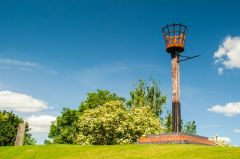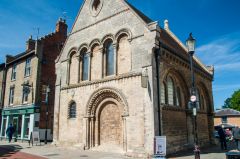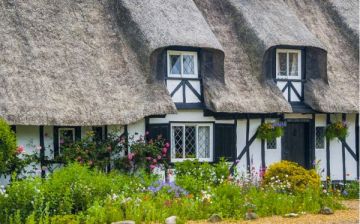
The historic town of Huntingdon is most famous as the birthplace of Oliver Cromwell. But the history of the town goes back long before Cromwell's era. There are indications of a Roman villa at Huntingdon, and we know that a Saxon town existed here as early as 650 AD.
The town was fortified by the Anglo-Saxons against the Danes during the 9th and 10th centuries, though it appears that the two sides took possession of the town in turn. As early as the mid 10th century Huntingdon possessed its own mint and a market soon followed.
In 1068 William the Conqueror rebuilt and expanded upon an existing Saxon fortification to create Huntingdon Castle. That castle did not last long, however - it was besieged by Henry II in 1174 and destroyed. Later the site was refortified and used by Cromwell as an artillery platform during the Civil War! The castle fortifications now consist of massive, overgrown earthworks.

For centuries Huntingdon was the county town of Huntingdonshire, but the old county has been swept away in modern governmental reorganisation, and Huntingdon now finds itself a part of Cambridgeshire.
The town is joined by a 14th-century bridge to Godmanchester across the river, but within the town, most of the buildings are from the 17th and 18th centuries. In one of the latter, the poet William Cowper lived for a short time.
Nearby Hinchingbrooke House was the family home of the Cromwells. Built in the 11th century, the former nunnery came into the Cromwell's hands at the Dissolution of the monasteries. The house later passed to the Montagus, Earls of Sandwich, who added the terraced gardens.

Visiting Huntingdon
Huntingdon High Street has been pedestrianised and makes it easy for visitors to stroll between the historic attractions in this attractive old town. At the foot of the High Street is Castle Hills, the site of a Norman castle.
A short stroll away is the picturesque 14th-century Town Bridge, which has a distinct kink in the middle. Apparently, the boroughs of Godmanchester and Huntingdon each started building their half of the bridge, but without co-operating or exchanging information. So when they met in the middle they discovered they weren't in alignment.
On one side of the paved Market Square is All Saints, one of two surviving medieval churches in Huntingdon. Within the church, near the pulpit, is the site of the Cromwell family vault. Near the south door is the font where (we presume) Cromwell was baptised.
Across from the church is the Cromwell Museum, housed in a gorgeous 12th-century Norman building with beautifully carved blind arcading. The museum features Cromwell exhibits and memorabilia including items owned by Oliver Cromwell, such as his wide-brimmed hat and several of his swords.
About Huntingdon
Address: Huntingdon,
Cambridgeshire,
England
Attraction Type: Town
Location map
OS: TL237 716
Photo Credit: David Ross and Britain Express
POPULAR POSTS
HERITAGE
 We've 'tagged' this attraction information to help you find related historic attractions and learn more about major time periods mentioned.
We've 'tagged' this attraction information to help you find related historic attractions and learn more about major time periods mentioned.
Historic Time Periods:
Find other attractions tagged with:
12th century (Time Period) - 14th century (Time Period) - castle (Architecture) - Cromwell (Person) - Medieval (Time Period) - Norman (Architecture) - Oliver Cromwell (Person) - Roman (Time Period) - Saxon (Time Period) -
NEARBY HISTORIC ATTRACTIONS
Heritage Rated from 1- 5 (low to exceptional) on historic interest
Huntingdon, All Saints Church - 0.1 miles (Historic Church) ![]()
Huntingdon Castle - 0.3 miles (Castle) ![]()
Houghton Mill - 2.8 miles (Historic Building) ![]()
Hemingford Grey Manor - 3.4 miles (Historic Building) ![]()
Hemingford Grey, St James Church - 3.4 miles (Historic Church) ![]()
Offord Darcy, St Peter's Church - 3.5 miles (Historic Church) ![]()
Buckden Towers - 3.7 miles (Historic Building) ![]()
Buckden, St Mary's Church - 3.7 miles (Historic Church) ![]()










